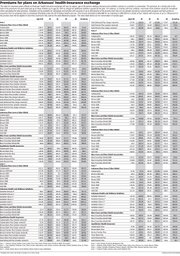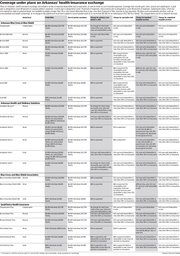If all goes as planned, Arkansas’ health insurance exchange will open for business Tuesday, allowing thousands of Arkansans to shop for coverage through an online portal set up by the federal government.
Premiums for each plan will vary by age, place of residence, family size and whether the person seeking insurance is a smoker. Insurance companies will not be able to turn down applicants or charge them more because of their medical histories.
Most of the more than 500,000 people in the state who lack health insurance are expected to qualify for subsidies, either through tax credits that will be paid directly to insurance companies or through the state’s Medicaid program.
According to filings with the Arkansas Insurance Department, the unsubsidized monthly premiums on plans for one individual will range from $67.76 for catastrophic coverage if the individual is age 20 or younger, to $1,456.11 if the person is a 64-year-old smoker who chooses a plan that offers vision and dental benefits.
Co-payments, co-insurance and deductibles will vary with each plan. To simplify comparisons, the 2010 Patient Protection and Affordable Care Act requires the plans to be labeled based on what amount of a typical patient’s medical expenses the plans are designed to cover - 80 percent for the gold-level plans, 70 percent for silver and 60 percent for bronze.
For those who qualify for Medicaid, the Medicaid program will pay the entire premium for a silver-level plan of the applicant’s choice. The amount of the tax-credit subsidies vary according to income.
Catastrophic plans, available to people under age 30 or who would otherwise have to pay more than 8 percent of their incomes for insurance, offer less coverage than bronze. Subsidies cannot be used to buy catastrophic plans.
But like the bronze, silver and gold plans, catastrophic plans cap patients’ out-of pocket expenses, including deductibles, co-payments and co-insurance payments, at $6,350 for an individual or $12,700 for a family. Co-insurance refers to the percentage of the cost for a health service that an insurance plan doesn’t cover and that an individual pays once the plan deductible has been met.
Each plan must offer a list of specified benefits, including outpatient care, prescription drugs, emergency care, mental-health services, hospitalization, rehabilitative and habilitative services, laboratory services, and maternity care.
In addition, preventative services, such as immunizations and health screenings, must be covered at no charge to the patient.
Coverage under the plans will start Jan. 1. Those who qualify for Medicaid can sign up throughout the year. Everyone else can sign up only during the enrollment period, which starts Tuesday and runs through March 31, or after certain life events, such as the loss of a job.
Those who fail to obtain coverage for next year will face a penalty of $95 or 1 percent of their incomes, whichever is greater.
To mark the opening of the insurance exchange, the state Insurance Department will hold an enrollment fair Tuesday at the Clinton School of Public Service in Little Rock. Insurance Department spokesman Heather Haywood said people will be able to sign up for coverage with the help of outreach workers, using computers set up throughout the building.
Workers from the Department of Human Services and the Insurance Department’s Senior Health Insurance Information Program will be at the event to answer questions, she said.
The department’s goal is that, no matter who shows up, “we have the appropriate resources on hand to assist them,” she said.
THE SUBSIDIES
Under the expansion of the state’s Medicaid program approved by the Legislature this year, Medicaid assistance will be available to adults who have incomes of up to 138 percent of the poverty level - $15,860 for an individual or $32,500 for a family of four.
Those who don’t qualify for Medicaid but have incomes of less than 400 percent of the poverty level will be eligible for the tax-credit subsidies. The income threshold for those subsidies is $45,960 for an individual or $94,200 for a family of four.
The tax credits are available to those who don’t have access to employer-sponsored coverage, as well as those whose employers don’t offer coverage that is considered affordable, meaning that the coverage would cost more than 9.5 percent of the employees’ incomes.
The amount of the subsidy will depend on the applicant’s income and the amount the applicant would have to pay for the second-lowest-priced silver plan available.
In Arkansas, for individuals across all ages, the second-lowest-priced silver plan is Arkansas Blue Cross and Blue Shield’s Silver 2500 plan, which has a $2,500 deductible and a $25 co-payment for doctor’s visits, Insurance Department filings show.
For a 30-year-old in Pulaski County, that plan will have a premium of $271.92 a month. Accordingly, if the 30-year-old’s income were 139 percent of the poverty level, he would receive a subsidy of $231.99 a month - intended to ensure that he would not have to pay more than 3 percent of his income, or $39.93 per month, for the coverage.
The amount of the subsidy is reduced for those with higher incomes. If the 30-year-old’s income were 250 percent of the poverty level, or $28,725, he would receive a subsidy of $79.22, intended to ensure that he does not have to spend more than 8.05 percent of his income for the plan.
The subsidy doesn’t limit an individual to the benchmark silver plan. It can also be used for bronze or gold plans.
In Pulaski County, a bronze plan for a 30-yearold will be available for as little as $205.49, meaning the 30-year-old with an income of 139 percent of the poverty level would be able to pay the entire cost of a bronze plan with his subsidy.
In fact, Insurance Department filings indicate that most people with incomes of up to about 150 percent of the poverty level - $17,235 for an individual or $35,325 for a family of four - will be eligible for a subsidy large enough to cover the entire premium for a bronze plan.
For those with incomes of up to 250 percent of the poverty level, additional subsidies will be available to reduce co-payments, co-insurance and deductibles, but those subsidies will be available only through the silver plan.
For instance, for someone with an income of 150 percent to 200 percent of the poverty level, the coverage provided by the plan would be increased so that it would cover 87 percent of a typical patient’s costs.
Similarly, those who qualify for Medicaid will be able to sign up only for a silver plan. Those with incomes below the poverty level will not have to pay any costs out of pocket. For those with higher incomes, Medicaid subsidies will reduce the required co-payments and cap any out of-pocket cost to the recipient at $604 for the year.
ENROLLMENT
The enrollment portal will be at the federal website, healthcare.gov, which promises to allow people to compare plans and find out whether they qualify for subsidies based on their incomes and household sizes.
Haywood said people will also be able to sign up over the phone by calling (800) 318-2596 or by mailing an application to the U.S. Department of Health and Human Services’ Centers for Medicare and Medicaid Services.
Those who qualify for Medicaid will start enrollment on the federal portal, Arkansas Human Services Department spokesman Amy Webb said. Once their eligibility has been determined, the Human Services Department will send them letters directing them to a state website.
Through letters mailed to food-stamp recipients, the Human Services Department has already identified more than 50,000 people who qualify for Medicaid and have indicated they want to enroll, Jonie Jones, director of the department’s division of county operations, said last week.
An online questionnaire on the state website will identify “medically frail” applicants who will be enrolled in the traditional Medicaid program, rather than in private plans. The department has said about 10 percent of the 250,000 people who will become eligible for Medicaid on Jan. 1 will be enrolled in the traditional program because of their medical needs.
Others eligible for Medicaid plans will choose plans on the state website. If they fail to choose a plan within two weeks of applying for coverage, they will be automatically assigned to a plan, she said. They will then have 30 days to switch plans, if they choose.
Through contracts with government entities, nonprofits and private companies, the Arkansas Insurance Department plans to hire 537 outreach workers, at a cost of about $16 million in federal grant money, to help people enroll.
As of Friday, 186 of the workers had completed their training with the Insurance Department, and 36 had received licenses. In addition, 1,028 insurance agents had completed training to sell plans on the exchange, and 382 had received licenses to sell the plans.
People can call the Insurance Department at (855) 283-3483 for information on how to reach an outreach worker or agents, Haywood said.
While subsidies are available only through plans on the exchange, people can also sign up for coverage directly with insurance companies. Arkansas’ three-largest health insurers - Arkansas Blue Cross and Blue Shield, United Healthcare and QualChoice - are allowing people to keep their existing individual policies through Dec. 30, 2014.
In addition to comparing the costs, people should check to make sure their doctors are in the insurance company network and that the plans will cover their prescriptions, said Anna Strong, health policy director for Arkansas Advocates for Children and Families.
The subsidies will make the exchange plans attractive for many families, she said.
“I think these plans are a much better deal than what people are able to get in the market right now,” Strong said.
Front Section, Pages 1 on 09/29/2013


